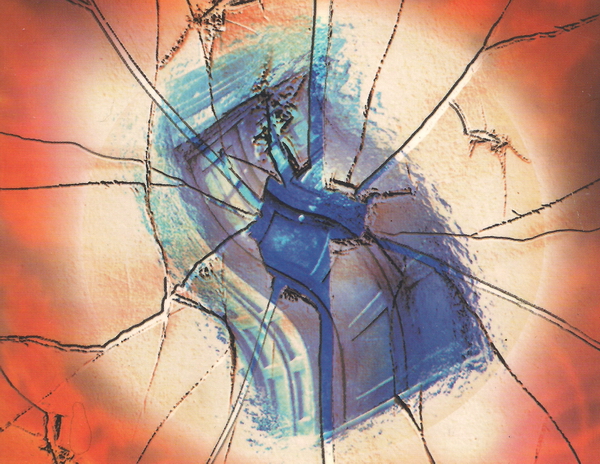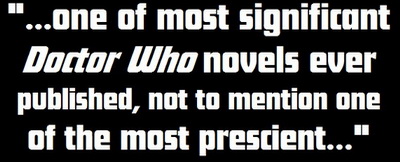|
| |
|
STORY PLACEMENT THIS STORY TAKES PLACE BETWEEN THE NOVELS "DOMINION" AND "AUTUMN MIST."
WRITTEN BY JONATHAN BLUM & KATE ORMAN
RECOMMENDED PURCHASE OFFICIAL BBC 'EIGHTH DOCTOR' PAPERBACK (ISBN 0-563-55576-9) RELEASED IN JUNE 1999.
BLURB San Francisco HAschanged since thestart of 2000. Thelaws of physicskeep having ACIDflashbacks.The City has become amecca for those whorevel in impossiblecreatures - and thosewho want to see thempinned down and putaway.AND Sam’s past iscatching up with her– a past she didn’tknow THAT she had.With time runningout, the TIME LORDmust choose whichto sacrifice – a cityof wonders, or thelife of an old anddear friend... |
|
|
Unnatural History JUNE 1999
I can see why Unnatural History is one of Kate Orman’s least popular works. A dense and convoluted tapestry of temporal technobabble, devoid of her generally deft and lyrical prose, it isn’t difficult to understand why some readers gave up on it, and a number of those that finished it condemned it. But as a sucker for the wibbly-wobbly and especially the timey-wimey, I loved it; and today I probably love it even more. Brimming with mind-blowing concepts (many of which have wry, metafictional connotations), inspired character drama, and stunning set pieces, Jonathan Blum and Kate Orman’s third and final collaboration for the range is, in my view at least, their finest.
For starters, Blum and Orman’s plot is staggeringly ambitious. Lawrence Miles’ earlier novel, Alien Bodies, had heavily implied that the Doctor had somehow changed blonde do-gooder Sam Jones from the woman that she was meant to be, and this idea was tentatively probed a little further in the intervening novels though fleeting references to a wretched, dark-haired alternative. Here the authors make this ‘dark Sam’ a reality: we pick up the tale in late 2002, where she’s living a humdrum life as a video store clerk. Some madman called the Doctor barges into her life, claiming that she should be blonde and travelling in time and space. Understandably shaken, she flees into the streets, where she is assailed by a young, knife-wielding urchin who calls her a “paradox.” Beginning to sense the truth of the Doctor’s words, Sam agrees to accompany him to San Francisco, where he claims the paradox originated.
This device allows the authors to present readers with a new – and much more interesting – Sam. Spiky, world-weary, and infinitely muckier than her holier-than-thou blonde counterpart, this dark-haired Sam really shakes things up inside the TARDIS. First she makes a forceful pass at the “back rub slut” Doctor, throwing herself at him with just as much vigour as Miss Pond recently did on television; and then, when he rejects her, she settles for Fitz, who has lusted after her blonde alter ego ever since he first saw her tits bounce as she ran back in The Taint.
These scenes, predictably slammed by many readers, are written ever so beautifully, and offer us unique insight into all three of the regulars, particularly Fitz. I especially enjoyed the passage where Fitz reflects on making love to dark Sam after the event, ruminating on how he felt more comfortable with her flabby stomach and imperfections than he would have had he got to fulfil his fantasy proper and bed the toned, blonde Sam. Once again it illustrates just how down-to-Earth and identifiable this chain-smoking, hesitant hero is. Perhaps more importantly though, these events inevitably stir up a lot of emotion in him, leaving him utterly lost at the end of the novel when the blonde Sam is restored and he is left feeling rejected.
However, it’s in the nuts and bolts that Unnatural History really stands out. Back in the day, the classic television series made a few passing references to “biodata”, though its precise nature or significance was never really explained. Alien Bodies would later pick up the ball and run with it, but it wasn’t until Unnatural History that we were explicitly told of its import. Simply put, biodata contains a person’s essence – past, present and future. Accordingly, were someone to meddle with it, they could potentially re-write your personal history, and in turn all of the events that you’ve been a part of. The same applies to your present and your future.
the Doctor regenerated in the TV Movie, his biodata was thrown in- to a state of flux. This instability was then exacerbated when the TARDIS had to turn back time to undo the Earth being sucked into its Eye of Harmony, corrupting the Doctor’s biodata to such an extent that he was left with at least seventeen conflicting pasts. The resultant energy then tore a crack in space-time through the middle of San Francisco, and when the TARDIS returned there several years later (objectively and subjectively), Sam fell into this space-time “scar” and her dark-haired counterpart appeared in London, completely oblivious to any change. Retrospectively, this left Sam’s biodata vulnerable to flux, leading the Doctor to assume that when she first met him immediately after the events of the TV Movie, while his biodata was still unsettled, his data somehow infected hers, twisting her possible futures and pasts and turning her into his perfect companion: the Sam that we have read about ever since. It’s not hard to appreciate why some found the plot impenetrable, but one has to admire the authors’ willingness to make full use of the extensive canvas that Doctor Who offers, and I can’t think of anything scarier than having someone tampering with one’s past.
“But he was still there. Even without a fixed face or name or body, even if his past contradicted itself from moment to moment, that didn’t matter. There was still something there, not just un-pinned-down but impossible to pin down. Something that even revelled in the fact that he couldn’t be easily understood. That said more things were possible than a simple explanation would allow.”
Better still, the principal antagonist of the piece - the eponymous “Unnaturalist”, Griffin - is a remarkable character as, in many ways, he’s me; or at least, the authors’ embodiment of the dogmatic, cataloguing fanboy, desperate to excise any contradictions from the history of the Doctor and pin him down to just one present; one past; one future; one history. This conceit allows Blum and Orman to portray the Doctor with greater allure than ever before – here he’s a visibly spiralling mass of conflicting possibilities, human and Time Lord at the same time, but equally neither and both. By the end of this novel the Doctor finds himself a mystery even to himself, the contradictions of his past having left him without even a shadow. It’s exquisite.
But Griffin isn’t the only antagonist here. Foreshadowing the events of Interference, Faction Paradox make their anarchic presence felt, their pocket-sized representative tricking the Doctor into restoring what he considers to be the real Sam, unwittingly creating a paradox. The blonde Sam wasn’t created as a result of the Doctor’s regeneration as he suspected – she was created as a result of dark Sam throwing herself into the Doctor’s biodata at the end of this story, which she could only do because the Doctor had brought her to the scar, which he only did because he’d already met the blonde Sam...
In my view Unnatural History is one of most significant Doctor Who novels ever published, not to mention one of the most prescient. Reading it again half-way through Matt Smith’s first season as the Doctor, I was astonished by the authors’ references to “spoilers”; their dry-run for the closing moments of Flesh and Stone; not to mention their plot being built around a crack in the fabric of time and space that allows histories to be rewritten! Though its prose may be a little more clinical than one would expect from these authors, this one is a veritable feast of extraordinary ideas and bold, mythology-shattering set pieces. It’s certainly not for everyone but, for me, it’s right on the money, and remains as unputdownable today as ever
it was.
|
|
|
Copyright © E.G. Wolverson 2010
E.G. Wolverson has asserted his right under the Copyright, Designs and Patents Act, 1988 to be identified as the author of this work. |
|
|
This novel suggests that it may have been Faction Paradox’s meddling with the Doctor’s biodata that retro-spectively caused the anomaly in his genetic coding, leaving him “half-human”, as posited in the TV Movie. Indeed, the Faction’s meddling here might explain a number of contradictions in the Doctor’s past and future history.
Unnatural History also includes a character named Larna, who may be the same character that featured heavily in The Infinity Doctors. This seems particularly likely as the boy from Faction Paradox refers to the Needle of that novel here, and the last time that we saw the Lady Larna she was leaving Gallifrey to try and mitigate the history-bending effects of that adventure.
|
|
|
Unless otherwise stated, all images on this site are copyrighted to the BBC and are used solely for promotional purposes. ‘Doctor Who’ is copyright © by the BBC. No copyright infringement is intended. |
|

.jpg)
.jpg)

 Blum
and Orman posit that when
Blum
and Orman posit that when